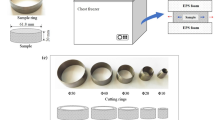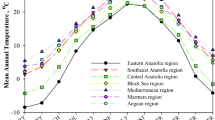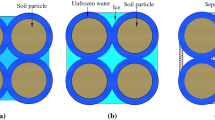Abstract
Frost heave susceptibility is a key index for designing the subgrade fillings of high-speed railways in cold regions. The existing methods for assessing frost heave susceptibility are mainly empirical or semi-empirical, and most of them are defined based on the fine content of soils. This study attempts to propose a new criterion based on the analytical solution of frost heave in the soil. A number of experiments are used to validate the proposed analytical model, which shows that the computed value of frost heave matches well with the measured data. The proposed model indicates that frost heave is a proportional function of the square root of time. Thus, the slope R named frost heave classification index of the proportional function is defined as a new index for frost heave susceptibility classification. A value of R less than 0.21 corresponds to a non-frost heave susceptibility condition, a value greater than 1.18 corresponds to a high frost heave susceptibility condition, and a value in the range of 0.21 and 1.18 means a frost heave susceptibility condition. R is directly related to the boundary temperatures and soil–water and soil-freezing characteristics. The parameter study shows that reducing the values of SWCC fitting parameter α and cold end temperature Tc or increasing the values of permeability of frozen soil kf, the saturated volumetric water content θs, the unfrozen water content at the frost front θu and the residual volumetric water content θr increases the possibility of frost heave. Compared with the existing method, the new index has a clear theoretical basis, and the parameters are easily obtained. It may be a rational method for assessing frost heave susceptibility.











Similar content being viewed by others
References
Akagawa S, Hori M, Sugawara J (2017) Frost heaving in ballast railway tracks. Proced Eng 189:547–553. https://doi.org/10.1016/j.proeng.2017.05.087
Askar Z, Zhanbolat S (2015) Experimental investigations of freezing soils at ground conditions of Astana, Kazakhstan. Sci Cold Arid Reg 7:399–406. https://doi.org/10.3724/SP.J.1226.2015.00399
ASTM Standard D5918–13e1 (2013) Standard Test Methods for Frost Heave and Thaw Weakening Susceptibility of Soils. ASTM International, West Conshohocken. https://www.astm.org/Standards/D5918.htm
Azmatch TF, Sego DC, Arenson LU, Biggar KW (2012) Using soil freezing characteristic curve to estimate the hydraulic conductivity function of partially frozen soils. Cold Reg Sci Technol 83–84:103–109. https://doi.org/10.1016/j.coldregions.2012.07.002
Bai R (2020) Study on the coupled heat-water-vapor-mechanics model of unsaturated soils. Dissertation, University of Chinese Academy of Sciences, Northwest Institute of Eco-Environment and Resources. (in Chinese)
Beskow G (1935) Soil freezing and frost heaving with special application to roads and railroads. Swedish Geol Surv Yearbook 26(3):375
Bilodeau JP, Dore G, Pierre P (2008) Gradation influence on frost susceptibility of base granular materials. Int J Pavement Eng 9(6):397–411. https://doi.org/10.1080/10298430802279819
Cai D (2016) Test on frost heaving spatial-temporal distribution of high speed railway subgrade in seasonal frozen soil region. China Railw Sci 37(3):16–21. https://doi.org/10.3969/j.issn.1001-4632.2016.03.03. (in Chinese)
Casagrande A (1931) Discussion of frost heaving. Highw Res Board, Proc 11:168–172
Chamberlain E J (1981) Frost Susceptibility of Soil: Review of Index Tests. US Army Corps of Engineers, CRREL, Hanover, New Hampshire.
Chen R, Wu J, Qi S, Wang H (2015) A method for measuring hydraulic parameters of coarse-grained soils for high-speed railway subgrade. Rock Soil Mech 36(12):3365–3372. https://doi.org/10.16285/j.rsm.2015.12.004. (in Chinese)
Cheng A (2006) Study on classification of frost susceptibility of railway subgrade filling. Dissertation, China Academy of Railway Sciences. (in Chinese)
Cheng X (2016) Frost heave characteristics and model for saturated expansive clay. Dissertation, Harbin Institute of Technology. (in Chinese)
Csathy T I, Townsend D L (1962) Pore size and field frost performance of soils. Highway Research Roard Bulletin, 67–80. http://onlinepubs.trb.org/Onlinepubs/hrbbulletin/331/331-005.pdf
Ćwiąkała M, Gajewska B, Kraszewski C, Rafalski L (2016) Laboratory investigations of frost susceptibility of aggregates applied to road base courses. Trans Res Procedia 14:3476–3484. https://doi.org/10.1016/j.trpro.2016.05.312
Dagli D (2017) Laboratory investigations of frost action mechanisms in soils. Dissertation, Luleå University of Technology.
Dai H, Wang X (1992) Frost heave susceptibility of highway bridge foundation in seasonal frost region. Cold Reg Sci Technol 20:141–146. https://doi.org/10.1016/0165-232X(92)90013-K
Devoie É, Gruber S, McKenzie JM (2022) A repository of 100+ years of measured soil freezing characteristic curves. Earth Syst Sci Data Discuss. https://doi.org/10.5194/essd-2022-61
Du X. (2015) A study on the frost heave mechanism of micro-frost-heave filling based on the interaction of frost heave of filling materialand coarse particles skeleton. Dissertation, China Academy of Railway Sciences. (in Chinese)
Fukuda M, Kim H S, Kim Y C (1997) Preliminary results of frost heave experiments using standard test sample provided by TC8. In: Ground Freezing 97, Frost Action in Soils: pp 25–30.
Gao J (2018) Study on mechanism and prevention technology of frost heaving of high-speed roadbed in seasonally frozen regions. Dissertation, University of Chinese Academy of Sciences, Northwest Institute of Eco-Environment and Resources. (in Chinese)
GB 50324 (2014) Code for Engineering Geological Investigation of Frozen Ground. China Planning Press, Beijing. (in Chinese)
GB/T 50123 (2019) Standard for Geotechnical Testing Method. China Planning Press, Beijing. (in Chinese)
He H, Teng J, Zhang S (2022) Rationality of frost susceptibility of soils. Chin J Geotechn Eng 44(2):224–23 ((in Chinese))
Hendry MT, Onwude LU, Sego DC (2016) A laboratory investigationof the frost heave susceptibility of fine-grained soil generated from the abrasion of a diorite aggregate. Cold Reg Sci Technol 123:91–98. https://doi.org/10.1016/j.coldregions.2015.11.016
Hoekstra P, Chamberlain E (1965) Frost heaving pressures. CRREL Internal Report.
Hu M, Cui X, Wang X, Liu H, Du W (2019) Experimental study of the effect of fine particles on permeability of the calcareous sand. Rock Soil Mech 40(8):2925–2930 ((in Chinese))
Hu Z, Guo J, Liang Z, Wang K, Feng Z, Chen Z (2020) Effects of clay content on physical and mechanical properties of fine tailings. Chin J Geotechn Eng 42(S1):16–21 ((in Chinese))
Janoo V C, Eaton R, Barna L (1997) Evaluation of Airport Subsurface Materials. Cold Regions Research and Engineering Special Report.
JGS 0171 (2009) Test Method for Frost Heave Prediction of Soils. Japan Geotechnical Society.
Jiang X, Wu L, Wei Y (2020) Influence of fine content on the soil–water characteristic curve of unsaturated soils. Geotech Geol Eng 38(2):1371–1378. https://doi.org/10.1007/s10706-019-01096-5
Jin HW, Lee J, Ryu BH, Akagawa S (2019) Simple frost heave testing method using a temperature-controllable cell. Cold Reg Sci Technol 157:119–132. https://doi.org/10.1016/j.coldregions.2018.09.011
Jin HW, Ryu BH, Kang J-M, Lee J (2021) Engineering approach to determination of the Segregation Potential by the upward-step-freezing testing method. Cold Reg Sci Technol 191:103361. https://doi.org/10.1016/j.coldregions.2021.103361
Johnson A E (2012) Freeze-thaw performance of pavement foundation materials. Dissertation, Iowa State University.
Konrad J M (1980) Frost heave mechanics. Dissertation, University of Alberta.
Konrad JM (1999) Frost susceptibility related to soil index properties. Can Geotech J 36(3):403–417. https://doi.org/10.1139/t99-008
Konrad JM (2005) Estimation of the segregation potential of fine-grained soils using the frost heave response of two reference soils. Can Geotech J 42(1):38–50. https://doi.org/10.1139/t04-080
Konrad JM, Morgenstern NR (1980) A mechanistic theory of ice formation in fine grained soils. Can Geotech J 17(4):473–486. https://doi.org/10.1139/t80-056
Konrad JM, Morgenstern NR (1981) The segregation potential of a freezing soil. Can Geotech J 18(4):482–491. https://doi.org/10.1139/t81-059
Leng J, Fu X, Yang J (2015) Experimental research of the subgrade padding frost heaving of high-speed railway. J Glaciol Geocryol 37(2):440–445 ((in Chinese))
Lin Z, Niu F, Li X, Li A, Liu M, Luo J, Shao Z (2018) Characteristics and controlling factors of frost heave in high-speed railway subgrade, Northwest China. Cold Reg Sci Technol 153:33–44. https://doi.org/10.1016/j.coldregions.2018.05.001
Liu G (2022) Experimental study on freeze-thaw and strength characteristics of Jiangxi red-clay due to artificial ground freezing. Dissertation, East China University of Technology. (in Chinese)
Loranger B, Doré G, Hoff I, Scibilia E (2022) Assessing soil index parameters to determine the frost susceptibility of crushed rock aggregates. Cold Reg Sci Technol 197:103489. https://doi.org/10.1016/j.coldregions.2022.103489
Lu C (2015) Subgrade engineering. China Railway Publishing House, Beijing ((in Chinese))
Lund MSM, Hansen KK, Andersen IB (2016) Frost susceptibility of sub-base gravel used in Pearl-Chain Bridges: an experimental investigation. Int J Pavement Eng 19:986–998. https://doi.org/10.1080/10298436.2016.1230429
Ma H (2015) Experimental study on frost heave of saturated subgrad silty clay in seasonal frozen region. Dissertation, Harbin Institute of Technology. (in Chinese)
Mageau D, Morgenstern NR (1979) Observations on moisture migration in frozen soils. Can Geotech J 17(1):54–60. https://doi.org/10.1139/t80-005
Mitchell JK, Soga K (2005) Fundamentals of soil behavior. Wiley, New York
Nemes A, Schaap MG, Leij F, Wösten JHM (2001) Description of the unsaturated soil hydraulic database UNSODA version 2.0. J Hydrol 251:151–162. https://doi.org/10.1016/S0022-1694(01)00465-6
NF P 98-080-1 (1992) Chaussées-Terrassements:Terminologie-Partie 1: Terminologie relative au calcul de dimensionnement des chaussées. (NF P 98–080–1 (1992) Pavements-Earthworks:Terminology-Part 1: Terminology relating to pavement design calculations. (in French))
Niu F, Li A, Luo J, Lin Z, Yin G, Liu M, Zheng H, Liu H (2017) Soil moisture, ground temperatures, and deformation of a high- speed railway embankment in Northeast China. Cold Reg Sci Technol 133:7–14. https://doi.org/10.1016/j.coldregions.2016.10.007
Niu F, Zheng H, Li A (2020) The study of frost heave mechanism of high-speed railway foundation by field-monitored data and indoor verification experiment. Acta Geotech 15(3):581–593. https://doi.org/10.1007/s11440-018-0740-8
Önalp A (1970) The mechanisms of frost heave in soils with particular reference to chemical stabilisation. Dissertation, University of Newcastle upon Tyne.
Peppin S, Majumdar A, Style R, Sander G (2011) Frost heave in colloidal soils. SIAM J Appl Math 71(5):1717–1732. https://doi.org/10.1137/100788197
Riddle JA (1973) Susceptibility to frost heaving of soils at selected sites along the Liard River Valley, determined by pore pressure measurements. Task force on Northern oil development. Environ Soc Committ Rep 73–3:465–511
Rieke R D (1982) The role of specific surface area and related index properties in the frost susceptibility of soils. Dissertation, Oregon State University.
Roe P G, Webster D C (1984) Specification for the TRRL frost-heave test. Report No SR829, Transport and Road Research Laboratory. Crowthorne, Berkshire, England.
Seehusen J (2011) Flytoget må kjøre i 80. https://www.tu.no/artikler/flytoget-ma-kjore-i-80/238210. Accessed 21 March 2018. ( Seehusen J (2011) Flytoget must run at 80 km/h. https://www.tu.no/artikler/flytoget-ma-kjore-i-80/238210. Accessed 21 March 2018. (in Norwegain))
Shen J, Hu M, Wang X, Zhang C, Xu D (2021) SWCC of calcareous silty sand under different fines contents and dry densities. Front Env Sci-Switz 9:682907. https://doi.org/10.3389/fenvs.2021.682907
Sheng D, Zhang S, Yu Z, Zhang J (2013) Assessing frost susceptibility of soils using PCHeave. Cold Reg Sci Technol 95:27–38. https://doi.org/10.1016/j.coldregions.2013.08.003
Sheng D, Zhang S, Niu F, Cheng G (2014) A potential new frost heave mechanism in high-speed railway embankments. Géotechnique 64(2):144–154. https://doi.org/10.1680/geot.13.P.042
Sheng D (2021) Frost susceptibility of soils-A confusing concept that can misguide geotechnical design in cold regions. Sci Cold Arid Reg 13(2):87–94
SoilVision (2002) SoilVision. Version 3 [computer program]. SoilVision Systems Limited, Saskatoon, Sask.
Teng J, Yasufuku N, Zhang S, He Y (2016) Modelling water content redistribution during evaporation from sandy soil in the presence of water table. Comput Geotech 75:210–224. https://doi.org/10.1016/j.compgeo.2016.02.009
Teng J, Shan F, He Z, Zhang S, Zhao G, Sheng D (2019) Experimental study of ice accumulation in unsaturated clean sand. Géotechnique 69:251–259. https://doi.org/10.1680/jgeot.17.P.208
Teng J, Liu J, Zhang S, Sheng D (2020) Modelling frost heave in unsaturated coarse-grained soils. Acta Geotech 15(11):3307–3320. https://doi.org/10.1007/s11440-020-00956-2
Teng J, Yan H, Liang S, Zhang S, Sheng D (2021) Generalising the Kozeny-Carman equation to frozen soils. J Hydrol 594:125885. https://doi.org/10.1016/j.jhydrol.2020.125885
Teng J, Liu J, Zhang S, Sheng D (2022) Frost heave in coarse-grained soils: experimental evidence and numerical modelling. Géotechnique. https://doi.org/10.1680/jgeot.21.00182
Tian H, Kong L (2010) Experimental research on effect of fine grains on water retention capacity of silty sand. Rock Soil Mech 31(1):56–60 ((in Chinese))
US Army Corps of Engineers (1984) Engineering and design: pavement criteria for seasonal frost conditions, mobilization construction. Engineer Manual No. 1110-3-138. Department of the Army Corps of Engineers, Washington, D .C, USA.
Wang Q (2017) Study on the frost heave behavior and strength of coarse-grained fillings from high-speed railway subgrade in cold region. Dissertation, Beijing Jiaotong University. (in Chinese)
Wang T, Ma H, Liu J, Luo Q, Wang Q, Zhan Y (2021) Assessing frost heave susceptibility of gravelly soils based on multivariate adaptive regression splines model. Cold Reg Sci Technol 181:103182. https://doi.org/10.1016/j.coldregions.2020.103182
Watanabe K, Wake T (2009) Measurement of unfrozen water content and relative permittivity of frozen unsaturated soil using NMR and TDR. Cold Reg Sci Technol 59:34–41. https://doi.org/10.1016/j.coldregions.2009.05.011
Wissa A, Martin R, Koutsoftas D (1972) Equipment for measuring the water permeability as a function of degree of saturation for frost susceptible soils. Massachusetts Institute of Technology, Department of Civil Engineering.
Xue K (2017) Moisture migrating and ice lens segregating process in freezing soil. Dissertation, University of Chinese Academy of Sciences, Northwest Institute of Eco-Environment and Resources. (in Chinese)
Yanful EK, Mousavi SM, Yang M (2003) Modeling and measurement of evaporation in moisture-retaining soil covers. Adv Environ Res 7(4):783–801. https://doi.org/10.1016/S1093-0191(02)00053-9
Ye Y, Wang Z, Cheng A, Luo M (2007) Frost heave classification of railway subgrade filling material and the design of anti-freezing layer. Chin Railw Sci 28(1):1–7 ((in Chinese))
Zhang F, Wilson G W, Fredlund D G (2017) Hydraulic properties for Devon silt considering volume change during drying. Canadian Geotechnical Conference. Ottawa, Canada. October 2017.
Zhang H, Zhang J, Zhang Z, Cai M (2016) Measurement of hydraulic conductivity of Qinghai-Tibet Plateau silty clay under subfreezing temperatures. Chin J Geotechn Eng 38(6):1030–1035 ((in Chinese))
Zhang S, Sheng D, Zhao G, Niu F, He Z (2016) Analysis of frost heave mechanisms in a high-speed railway embankment. Can Geotech J 53(3):520–529. https://doi.org/10.1139/cgj-2014-0456
Zhang S, Teng J, He Z, Liu Y, Liang S, Yao Y, Sheng D (2016) Canopy effect caused by vapour transfer in covered freezing soils. Géotechnique 66(11):927–940. https://doi.org/10.1680/jgeot.16.P.016
Zhao S (2019) Study on frost heave characteristics of Harbin-Mudanjiang high-speed line subgrade. Dissertation, Chang’an University. (in Chinese)
Zhou J, Pei W, Zhang X, Liu W, Wei C (2022) An easy method for assessing frost susceptibility of soils: the freezing ring test. Acta Geotech 17:5691–5707. https://doi.org/10.1007/s11440-022-01659-6
Acknowledgements
This research was supported by the National Natural Science Foundation of China (No. 51878665 and No. 52178376), Science and Technology Research and Development Program of China Railway Group Limited (Grant No: 2022-ZD-13), Program of Youth Talent Support for Hunan Province (2020RC3008), Postgraduate Innovation Project of Hunan Province, China (No.CX20210126), and Postgraduate Innovation Project of Central South University (No. 2021zzts0215).
Author information
Authors and Affiliations
Corresponding author
Additional information
Publisher's Note
Springer Nature remains neutral with regard to jurisdictional claims in published maps and institutional affiliations.
Rights and permissions
Springer Nature or its licensor (e.g. a society or other partner) holds exclusive rights to this article under a publishing agreement with the author(s) or other rightsholder(s); author self-archiving of the accepted manuscript version of this article is solely governed by the terms of such publishing agreement and applicable law.
About this article
Cite this article
Teng, J., He, H., Feng, X. et al. A novel criterion for assessing frost heave susceptibility of soils. Acta Geotech. 19, 2233–2249 (2024). https://doi.org/10.1007/s11440-023-02028-7
Received:
Accepted:
Published:
Issue Date:
DOI: https://doi.org/10.1007/s11440-023-02028-7




